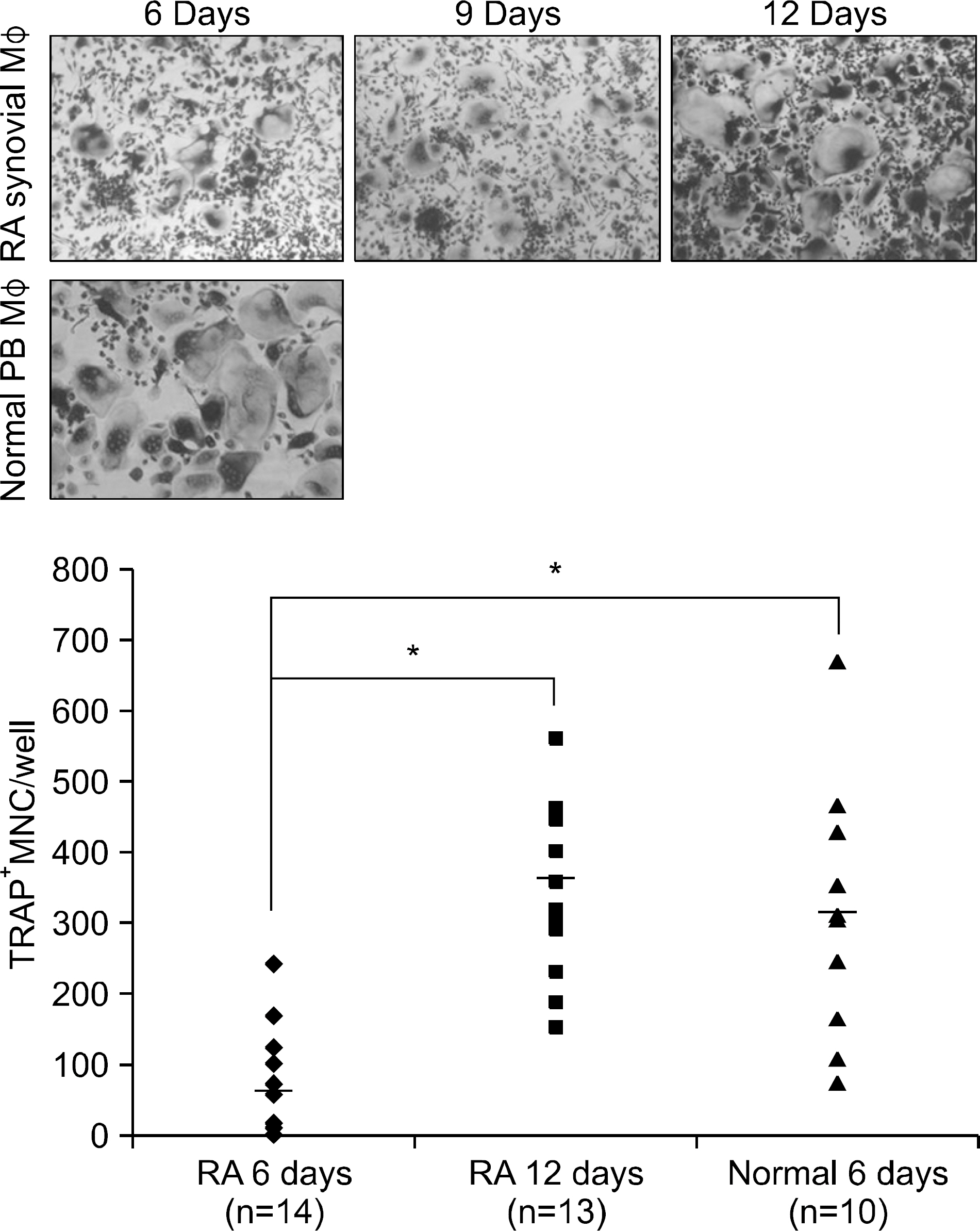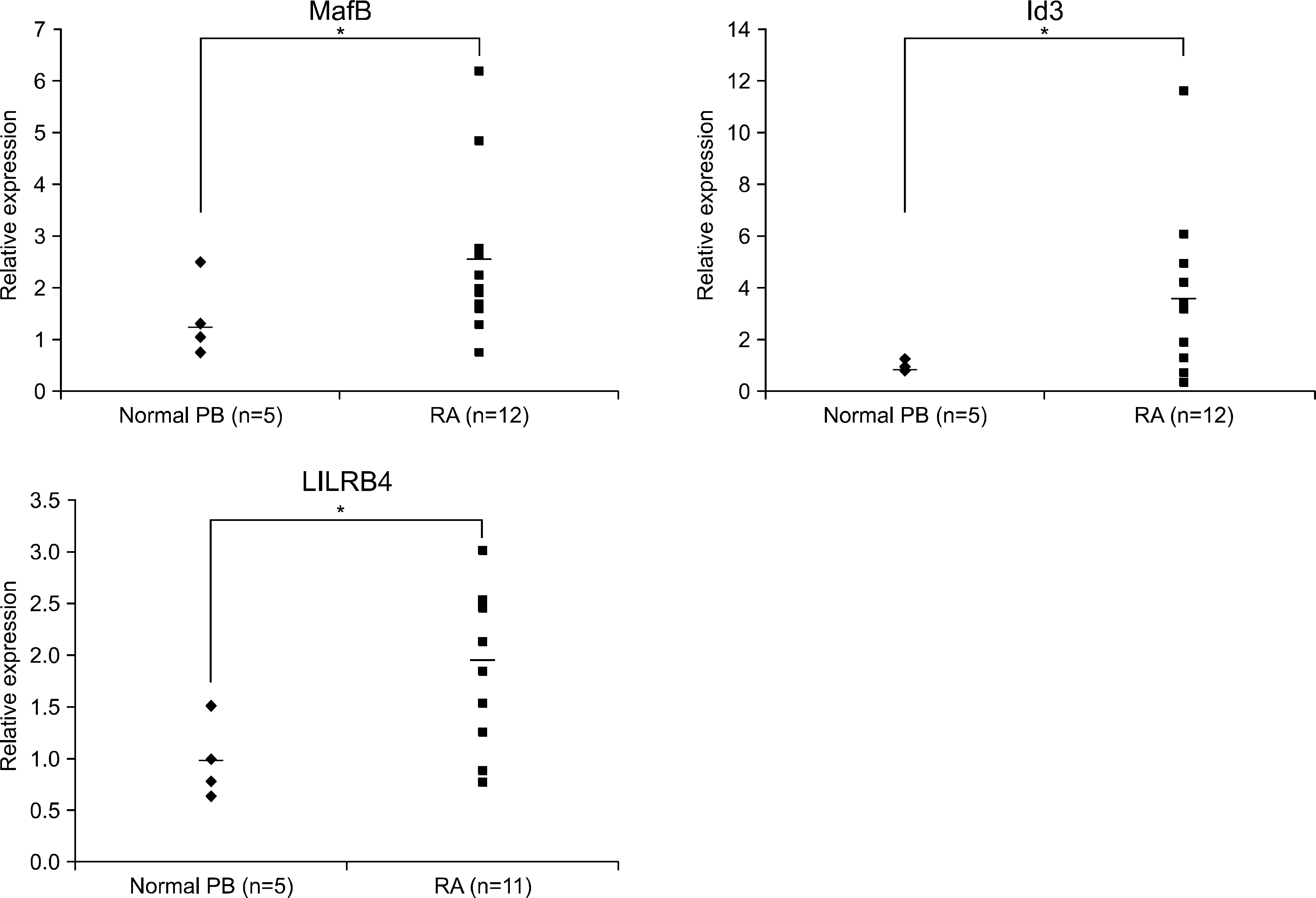J Rheum Dis.
2011 Mar;18(1):11-18. 10.4078/jrd.2011.18.1.11.
Expression of Osteoclastogenesis-related Genes in Rheumatoid Arthritis Synovial Macrophages
- Affiliations
-
- 1Department of Rheumatology, College of Medicine, Korea University, Seoul, Korea. jjdjmesy@korea.ac.kr
- 2The Hospital for Rheumatic Diseases, College of Medicine, Hanyang University, Seoul, Korea.
- KMID: 2223176
- DOI: http://doi.org/10.4078/jrd.2011.18.1.11
Abstract
OBJECTIVE
To examine the mechanism for the inhibited differentiation of osteoclasts in rheumatoid arthritis synovial CD14+ osteoclast precursors, the different expressions of the osteoclastogenesis-related genes in rheumatoid arthritis (RA) synovial fluid CD14+ osteoclast precursors were compared with those of normal peripheral blood (PB) CD14+ osteoclast precursors.
METHODS
The expression of osteoclastogenesis-related genes were examined using a gene expression oligonucleotide microarray. To validate the results of the microarray analysis, the mRNA expressions of osteoclastogenesis-related genes were measured by real-time PCR.
RESULTS
Comparative analysis of the mRNA profiles showed significantly different expression of osteoclastogenesis- related genes, such as MafB, Id3 and LILRB4, in the RA synovial CD14+ osteoclast precursors, compared to that of normal PB CD14+ osteoclast precursors.
CONCLUSION
The expression of the osteoclastogenesis-related genes in RA synovial CD14+ osteoclast precursors is different from that of the normal PB CD14+ osteoclast precursors. These results suggest that the different expression of osteoclastogenesis-related genes might be involved in the altered osteoclastogenesis in RA synovial osteoclast precursors.
MeSH Terms
Figure
Cited by 1 articles
-
Osteoclastogenesis in Rheumatoid Arthritis
Sang-Heon Lee
J Rheum Dis. 2011;18(2):71-73. doi: 10.4078/jrd.2011.18.2.71.
Reference
-
References
1. Han X, Kawai T, Taubman MA. Interference with immune-cell-mediated bone resorption in periodontal disease. Periodontol 2000. 2007; 45:76–94.2. Takayanagi H. Osteoimmunology: shared mechanisms and crosstalk between the immune and bone systems. Nat Rev Immunol. 2007; 7:292–304.3. Teitelbaum SL. Osteoclasts; culprits in inflammatory osteolysis. Arthritis Res Ther. 2006; 8:201.4. Walsh NC, Crotti TN, Goldring SR, Gravallese EM. Rheumatic diseases: the effects of inflammation on bone. Immunol Rev. 2005; 208:228–51.5. Ji JD, Tassiulas I, Park-Min KH, Aydin A, Mecklenbrauker I, Tarakhovsky A, et al. Inhibition of interleukin 10 signaling after Fc receptor ligation and during rheumatoid arthritis. J Exp Med. 2003; 197:1573–83.6. Park-Min KH, Ji JD, Antoniv T, Reid AC, Silver RB, Humphrey MB, et al. IL-10 suppresses calcium-mediated costimulation of receptor activator NF-kappa B signaling during human osteoclast differentiation by inhibiting TREM-2 expression. J Immunol. 2009; 183:2444–55.7. Aoki K, Didomenico E, Sims NA, Mukhopadhyay K, Neff L, Houghton A, et al. The tyrosine phosphatase SHP-1 is a negative regulator of osteoclastogenesis and osteoclast resorbing activity: increased resorption and osteopenia in me(v)/me(v) mutant mice. Bone. 1999; 25:261–7.8. Kim K, Kim JH, Lee J, Jin HM, Kook H, Kim KK, et al. MafB negatively regulates RANKL-mediated osteoclast differentiation. Blood. 2007; 109:3253–9.9. Kim K, Lee J, Kim JH, Jin HM, Zhou B, Lee SY, et al. Protein inhibitor of activated STAT 3 modulates osteoclastogenesis by down-regulation of NFATc1 and osteoclast-associated receptor. J Immunol. 2007; 178:5588–94.10. Lari R, Fleetwood AJ, Kitchener PD, Cook AD, Pavasovic D, Hertzog PJ, et al. Macrophage lineage phenotypes and osteoclastogenesis–complexity in the control by GM-CSF and TGF-beta. Bone. 2007; 40:323–36.11. Lee J, Kim K, Kim JH, Jin HM, Choi HK, Lee SH, et al. Id helix-loop-helix proteins negatively regulate TRANCE- mediated osteoclast differentiation. Blood. 2006; 107:2686–93.12. Mori Y, Tsuji S, Inui M, Sakamoto Y, Endo S, Ito Y, et al. Inhibitory immunoglobulin-like receptors LILRB and PIR-B negatively regulate osteoclast development. J Immunol. 2008; 181:4742–51.13. Takayanagi H, Kim S, Matsuo K, Suzuki H, Suzuki T, Sato K, et al. RANKL maintains bone homeostasis through c-Fos-dependent induction of interferon-beta. Nature. 2002; 416:744–9.14. Takayanagi H, Ogasawara K, Hida S, Chiba T, Murata S, Sato K, et al. T-cell-mediated regulation of osteoclastogenesis by signalling crosstalk between RANKL and IFN-gamma. Nature. 2000; 408:600–5.15. Takeshita S, Namba N, Zhao JJ, Jiang Y, Genant HK, Silva MJ, et al. SHIP-deficient mice are severely osteo-porotic due to increased numbers of hyper-resorptive osteoclasts. Nat Med. 2002; 8:943–9.16. Wei S, Wang MW, Teitelbaum SL, Ross FP. Interleukin- 4 reversibly inhibits osteoclastogenesis via inhibition of NF-kappa B and mitogen-activated protein kinase signaling. J Biol Chem. 2002; 277:6622–30.17. Haringman JJ, Gerlag DM, Zwinderman AH, Smeets TJ, Kraan MC, Baeten D, et al. Synovial tissue macrophages: a sensitive biomarker for response to treatment in patients with rheumatoid arthritis. Ann Rheum Dis. 2005; 64:834–8.18. Herrak P, Görtz B, Hayer S, Redlich K, Reiter E, Gasser J, et al. Zoledronic acid protects against local and systemic bone loss in tumor necrosis factor-mediated arthritis. Arthritis Rheum. 2004; 50:2327–37.19. Kinne RW, Stuhlmüller B, Burmester GR. Cells of the synovium in rheumatoid arthritis. Macrophages. Arthritis Res Ther. 2007; 9:224.20. Smink JJ, Bégay V, Schoenmaker T, Sterneck E, de Vries TJ, Leutz A. Transcription factor C/EBPbeta isoform ratio regulates osteoclastogenesis through MafB. EMBO J. 2009; 28:1769–81.21. Conaway HH, Persson E, Halén M, Granholm S, Svensson O, Pettersson U, et al. Retinoids inhibit differentiation of hematopoietic osteoclast progenitors. FASEB J. 2009; 23:3526–38.22. Jacquin C, Koczon-Jaremko B, Aguila HL, Leng L, Bucala R, Kuchel GA, et al. Macrophage migration inhibitory factor inhibits osteoclastogenesis. Bone. 2009; 45:640–9.23. Oshima S, Onodera S, Amizuka N, Li M, Irie K, Watanabe S, et al. Macrophage migration inhibitory factor-deficient mice are resistant to ovariectomy-induced bone loss. FEBS Lett. 2006; 580:1251–6.24. Kurowska-Stolarska M, Distler JH, Jüngel A, Rudnicka W, Neumann E, Pap T, et al. Inhibitor of DNA binding/differentiation 2 induced by hypoxia promotes synovial fibroblast-dependent osteoclastogenesis. Arthritis Rheum. 2009; 60:3663–75.25. Ji JD, Park-Min KH, Shen Z, Fajardo RJ, Goldring SR, McHugh KP, et al. Inhibition of RANK expression and osteoclastogenesis by TLRs and IFN-gamma in human osteoclast precursors. J Immunol. 2009; 183:7223–33.
- Full Text Links
- Actions
-
Cited
- CITED
-
- Close
- Share
- Similar articles
-
- Study of the Gene Expressions in Rheumatoid Arthritis Synovial Macrophages Using Network Analysis
- Synovial Chondromatosis in Knee Masquerading as Tuberculosis Arthritis
- Screening of Genes Regulating TNF-alpha-mediated Synovial Hyperplasia in Rheumatoid Arthritis
- Effects of TGF-beta, GM-CSF, and PDGF on Proliferation and Expression of Cytokine and Metalloproteinase Genes in Rheumatoid Synovial Cells
- Expression of p53 protein in rheumatoid arthritis synovium. An immunohistochemical analysis



